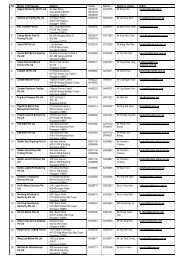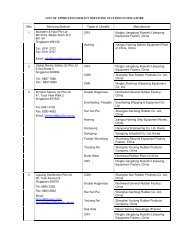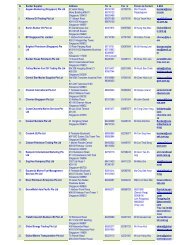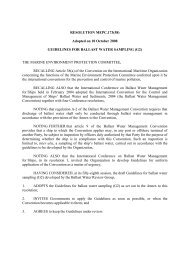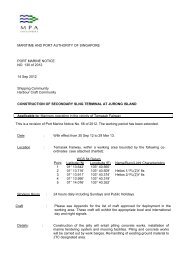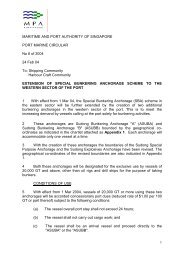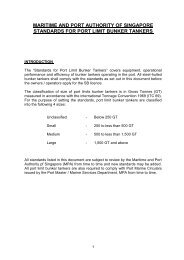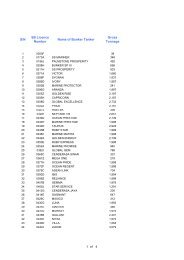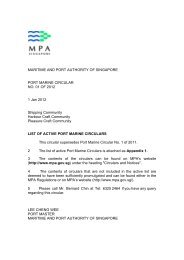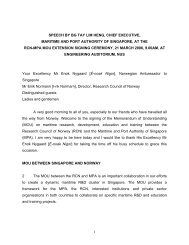HAZE ALERT - 24-HOUR PSI LEVEL - MPA
HAZE ALERT - 24-HOUR PSI LEVEL - MPA
HAZE ALERT - 24-HOUR PSI LEVEL - MPA
Create successful ePaper yourself
Turn your PDF publications into a flip-book with our unique Google optimized e-Paper software.
MARITIME AND PORT AUTHORITY OF SINGAPORE<br />
PORT MARINE NOTICE<br />
NO. 81 OF 2013<br />
19 Jun 2013<br />
Shipping Community<br />
Harbour Craft Community<br />
<strong>HAZE</strong> <strong>ALERT</strong> – <strong>24</strong>-<strong>HOUR</strong> <strong>PSI</strong> <strong>LEVEL</strong> < 100<br />
It has been reported that the average <strong>24</strong>-hour <strong>PSI</strong> levels is less than 100 i.e.<br />
good to moderate.<br />
2 Shipping & Harbour Craft communities, shipowners, shipping agents, terminal<br />
operators and marine service providers are advised to monitor the <strong>PSI</strong> level through<br />
media.<br />
3 Please ensure that sufficient respirators are available for your workers engaged<br />
in outdoor activities in the port waters. A copy of the Ministry of Manpower (MOM)<br />
guidelines for outdoor works during haze is attached for your guidance.<br />
DAKNASHAMOORTHY GANASEN<br />
DEPUTY PORT MASTER<br />
MARITIME AND PORT AUTHORITY OF SINGAPORE
MOM’s GUIDELINES FOR THE PROTECTION OF EMPLOYEES AGAINST THE EFFECTS OF <strong>HAZE</strong> AT<br />
WORKPLACES – updated 17 June 2013<br />
(http://mom.gov.sg/Documents/safety-health/factsheets-circulars/Workplace%20Guidelines%20During%20a%20Haze.pdf)<br />
<strong>24</strong>-Hour <strong>PSI</strong><br />
Reading<br />
81– 100<br />
(moderate)<br />
101-200<br />
(unhealthy)<br />
201-300<br />
(very<br />
unhealthy)<br />
301-400<br />
(hazardous)<br />
>400<br />
(very<br />
hazardous)<br />
General Health Effects Measures to be taken by employer Measures to be taken by<br />
employees<br />
Few or none for the<br />
general population<br />
Mild aggravation of<br />
symptoms among<br />
susceptible people, with<br />
irritation symptoms in the<br />
healthy population<br />
Significant aggravation of<br />
symptoms and<br />
decreased tolerance in persons<br />
with heart<br />
or respiratory illness;<br />
widespread symptoms in healthy<br />
population<br />
Early onset of certain<br />
diseases in addition to<br />
significant aggravation of<br />
symptoms and decreased<br />
exercise tolerance in healthy<br />
persons<br />
May be life threatening to ill<br />
and elderly persons. Healthy<br />
people experience adverse<br />
symptoms that affect<br />
normal activity.<br />
• Identify susceptible employees<br />
• Identify types of outdoor work to be reduced when<br />
there is haze<br />
• Determine criteria for stopping outdoor work<br />
• Ensure sufficient stock of disposable N95<br />
respirators<br />
• Improve efficiency of air cleaning devices for<br />
enhanced protection of indoor workers<br />
• Implement haze communication system between<br />
employer and employees.<br />
• Communicate to employees on measures<br />
taken to protect their safety and health during haze<br />
• Provide suitable respirators to susceptible<br />
employees working outdoors<br />
• If susceptible employees have difficulty<br />
working outdoors, employers should deploy them to<br />
work indoor<br />
• Outdoor work which involves strenuous physical<br />
activity should be minimised.<br />
• Susceptible employees should be deployed to<br />
work<br />
indoor, preferably doing work which is not physically<br />
strenuous<br />
• Provide suitable respirators to all employees<br />
carrying out outdoor work<br />
• Outdoor work which involves strenuous physical<br />
activity should be avoided.<br />
• Outdoor work which involves strenuous physical<br />
activity should be avoided<br />
• Must provide suitable respirators to all employees<br />
carrying out outdoor work<br />
• Risk assessment* should consider the additional<br />
risk posed by poor visibility for work activities such as<br />
lifting operations involving tower and mobile cranes.<br />
• Outdoor work should be avoided.<br />
• Risk assessment* should consider the impact of<br />
haze on the health of all employees, especially those<br />
working outdoors. For those engaged in emergency<br />
and essential services, the risk should be mitigated by<br />
wearing suitable respirators.<br />
• All employees<br />
carrying out outdoor work to<br />
undergo respirator fit testing<br />
• All employees know<br />
when to stop outdoor work<br />
• Susceptible employees<br />
must use suitable respirators if<br />
working outdoor<br />
• All employees carrying out<br />
outdoor work should use<br />
suitable respirators<br />
• Susceptible employees<br />
should work indoor,<br />
preferably doing work which is<br />
not physically strenuous.<br />
• All employees carrying out<br />
outdoor work should wear suitable<br />
respirators<br />
• Susceptible employees<br />
should remain indoors and<br />
avoid strenuous work<br />
• All employees should<br />
remain indoors and avoid<br />
strenuous work.<br />
• All employees carrying out<br />
emergency and essential<br />
services must wear suitable<br />
respirators<br />
* Risk Assessment:<br />
During haze, employees will be exposed to higher levels of WSH risk due to poor visibility and/or ill effects of haze.<br />
Employers should conduct a proper risk assessment and implement appropriate measures, including specifying when to<br />
stop work, so as to ensure that risks identified are minimised or mitigated. If the WSH risk cannot be mitigated, such<br />
activities should stop. The work should only resume when precautions have been taken to reduce this risk.



